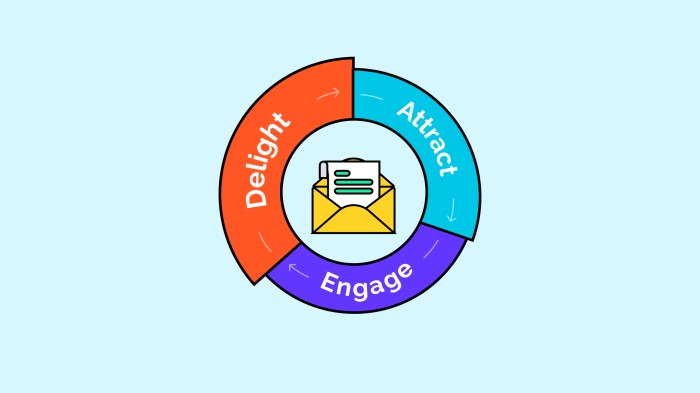How can email marketing fuel your overall inbound strategy? Email marketing plays a crucial role in attracting, nurturing, and converting leads into loyal customers. By integrating email marketing into your inbound strategy, you can effectively engage your target audience, build relationships, and drive business growth.
This comprehensive guide will explore the benefits of email marketing for inbound strategies, provide practical tips for creating effective email campaigns, and discuss key metrics for measuring success.
The Importance of Email Marketing in the Inbound Strategy: How Can Email Marketing Fuel Your Overall Inbound Strategy

Email marketing plays a pivotal role in the inbound methodology, which emphasizes attracting, engaging, and delighting customers. By fostering personalized connections with subscribers, email marketing enhances the inbound strategy in the following ways:
- Lead Generation:Email marketing campaigns generate qualified leads by offering valuable content, such as blog posts, webinars, and whitepapers, in exchange for contact information.
- Lead Nurturing:Automated email sequences nurture leads by providing targeted content tailored to their interests and stage in the buyer’s journey.
- Customer Conversion:Email marketing promotes products and services to leads and existing customers, encouraging them to make purchases or take desired actions.
- Customer Engagement:Regular email communication keeps customers informed, engaged, and loyal to the brand.
Successful Inbound Email Marketing Campaigns
Notable examples of successful inbound email marketing campaigns include:
- HubSpot’s “Email Marketing Certification”course generated over 100,000 leads and increased email open rates by 20%.
- Salesforce’s “Trailhead”platform uses email marketing to provide personalized learning paths and engage prospects.
- Slack’s “Welcome” email serieseffectively introduces new users to the platform and encourages them to adopt its features.
How to Use Email Marketing to Attract Leads

Creating compelling email content that attracts leads is crucial. Here are some tips:
- Provide Value:Offer valuable content that addresses the target audience’s pain points and interests.
- Personalize Content:Use segmentation and personalization techniques to tailor content to specific subscriber groups.
- Use a Clear Call-to-Action (CTA):Encourage subscribers to take the desired action, such as downloading a lead magnet or signing up for a webinar.
Lead Magnets and Gated Content
Lead magnets and gated content are effective lead generation techniques in email marketing:
- Lead Magnets:Offer valuable resources, such as e-books, whitepapers, or templates, in exchange for contact information.
- Gated Content:Make premium content, such as exclusive blog posts or videos, available only to subscribers who provide their email addresses.
Email Automation for Lead Nurturing
Email automation sequences nurture leads by sending targeted emails based on specific triggers:
- Welcome Emails:Send automated welcome emails to new subscribers to introduce the brand and provide valuable information.
- Behavior-Triggered Emails:Trigger emails based on subscriber actions, such as visiting a particular webpage or downloading a lead magnet.
- Drip Campaigns:Send a series of automated emails over time to provide valuable content and nurture leads through the buyer’s journey.
Using Email Marketing to Convert Leads into Customers

To convert leads into customers using email marketing, follow these strategies:
Email List Segmentation
Segment email lists based on demographics, behavior, or interests to send targeted campaigns:
- Demographic Segmentation:Target subscribers based on age, gender, location, or job title.
- Behavioral Segmentation:Segment subscribers based on their interactions with the brand, such as email opens, clicks, or purchases.
- Interest Segmentation:Divide subscribers into groups based on their expressed interests or content preferences.
Promoting Products and Services
Use email marketing to promote products and services to leads and existing customers:
- Product Announcements:Announce new product launches or updates to generate excitement and interest.
- Exclusive Offers:Provide exclusive discounts, promotions, or early access to new products to encourage purchases.
- Customer Testimonials:Share customer testimonials to build credibility and influence purchase decisions.
Optimizing Email Campaigns for Conversions
Optimize email campaigns for conversions by following best practices:
- Clear and Concise Subject Lines:Craft compelling subject lines that grab attention and encourage opens.
- Mobile-Friendly Design:Ensure emails are optimized for viewing on mobile devices, where most emails are opened.
- A/B Testing:Conduct A/B tests to compare different email elements, such as subject lines, content, or CTAs, to determine the most effective versions.
How to Measure the Success of Email Marketing Campaigns

Measuring the success of email marketing campaigns is essential to optimize performance:
Key Metrics to Track
Track key metrics to assess campaign performance:
- Email Open Rate:The percentage of subscribers who opened an email campaign.
- Click-Through Rate (CTR):The percentage of subscribers who clicked on a link within an email campaign.
- Conversion Rate:The percentage of subscribers who took a desired action, such as making a purchase or signing up for a webinar.
- Return on Investment (ROI):The financial return generated from an email marketing campaign compared to its cost.
Using Analytics to Improve Campaigns, How can email marketing fuel your overall inbound strategy
Use email marketing analytics to identify areas for improvement:
- Monitor Open and Click Rates:Track open and click rates to identify subject lines and content that resonate with subscribers.
- Analyze Conversion Rates:Track conversion rates to determine which email campaigns are most effective at driving desired actions.
- Conduct Segmentation Analysis:Analyze email performance by segment to identify groups with higher engagement and conversion rates.
Email Marketing Reporting Dashboards
Create email marketing reporting dashboards to visualize campaign performance and identify trends:
- Key Metrics Dashboard:Display key metrics, such as open rates, CTRs, and conversion rates, in an easy-to-read format.
- Campaign Comparison Dashboard:Compare the performance of different email campaigns to identify best practices and areas for improvement.
- Subscriber Engagement Dashboard:Track subscriber engagement metrics, such as email opens, clicks, and unsubscribes, to identify trends and improve email deliverability.
Key Questions Answered
What are the key benefits of using email marketing in an inbound strategy?
Email marketing offers numerous benefits for inbound strategies, including lead generation, lead nurturing, customer engagement, and sales conversions.
How can I create email content that attracts leads?
To create effective email content that attracts leads, focus on providing valuable information, using compelling subject lines, personalizing your messages, and optimizing for mobile devices.
What is the role of email automation in lead nurturing?
Email automation allows you to send targeted email messages to leads based on their behavior and preferences. This helps nurture leads through the buyer’s journey and increase conversion rates.